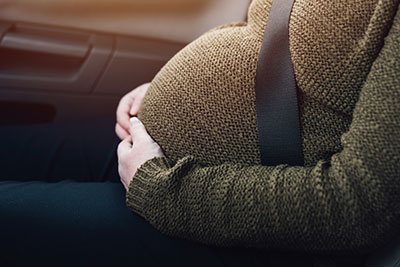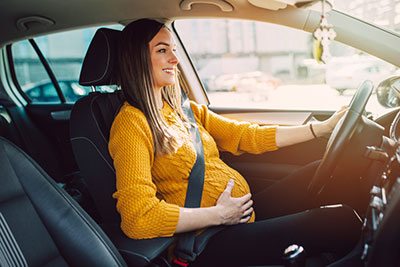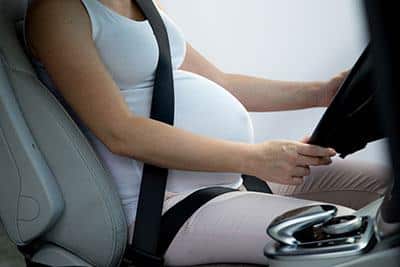Wearing a seat belt properly can reduce the chance of serious injury by 50%.
However, pregnant women often wonder whether pregnancy and seat belts are safe.
But here’s the kicker: Not only is it safe, but it's necessary to wear a lap and shoulder belt during pregnancy.
This future mom-friendly guide will explain how to wear a seat belt while pregnant properly and a few safety guidelines you must consider before taking the wheel.
More...
Take away key points:
Is It Safe to Wear a Seat Belt While Pregnant?

It is safe to wear a seatbelt while pregnant. Pregnant moms should always buckle up, whether they are drivers or passengers.
Wearing a three-point seat belt will prevent pregnant women from suffering abdominal injuries or even avoiding contact with the wheel during rear and frontal collisions, according to a recent study.
During a car accident, the impact of the seatbelt can cause injury to the unborn baby. Therefore, wearing a seat belt while pregnant is safer than not wearing it.
Car accidents are the leading cause of fetal trauma injuries, as specified by the U.S. National Library of Medicine. The most common traumatic injuries include placental abruption, maternal shock, uterine rupture, and direct fetal trauma.
Around 80% of unbelted pregnant passengers and drivers have experienced severe fetal outcomes, according to a 2008 study by the American Journal of Obstetrics and Gynecology. Over 170,000 pregnant passengers are involved in car crashes yearly, during which 62% experience fatal loss.
Driving while pregnant is allowed as long as you are not experiencing fatigue, nausea, or other symptoms that do not allow you to focus on the drive. However, if your doctor advises you not to wear a seat belt for medical reasons, you will need to get a Certificate of Exemption from Compulsory Seat Belt Wearing.
How to Properly Wear a Seat Belt While Pregnant?
A seat belt is only effective if it is installed and worn correctly. All pregnant women should use a three-point seat belt with a shoulder and lap belt. Although seat belts can get uncomfortable during pregnancy, you must learn how to wear the seat belt adequately.
Pregnancy Seat Belt Positioners: Helpful or Life-threatening?

Maternity seat belt positioners are not as safe as you may think. Although seat belt positioning devices may appear helpful, they are considered an aftermarket product with no crash testing data.
The seat belt positioning devices are not approved by federal standards, making them a risk for both the mom's and the baby's well-being. Only one seat belt positioner has been crash tested, which we will mention further down the article.
When the seat belt positioner is installed, it initially prevents the existing seat belt system from performing optimally during a crash. Once the seat belt functions have been compromised, nothing can guarantee seat belt safety during car crashes.
Many maternity seat belt positioners alter the current seat belt system by distancing the lap belt away from the hip bones and sliding it down to the thigh bone.
Types of pregnancy seat belt positioners
There are three common types of pregnancy seat belt positions:
- Positioners that are designed to keep the lap belt below the belly.
- Positioners remove the lap belt and create an anchor safety device between the legs.
- A cushion-like positioner is designed to be placed between the seat and the belly.
What do you need to consider before purchasing a pregnancy seat belt positioner?
If you do decide on purchasing a seat belt positioner, we suggest taking into consideration the following criteria:

What is a Tummy Shield?
A Tummy Shield is a unique seat belt positioned for future pregnant moms. The manufacturer of the Tummy Shield has developed a crash-tested product with exquisite engineering and safety results.
As we mentioned, the Tummy Shield is one of the best safety belt positions for pregnant drivers. The Tummy Shield is designed with a single piece stainless steel plate and anchor that has been strength tested. The anchor on the Tummy Shield holds firmly on the vehicle seat and does not slide around.
With the patented design, the Tummy Shield effectively redirects the seat belt away from the belly but secures the belt between the legs.
If you decide to purchase the Tummy Shield, we suggest you do so as soon as you start buying maternity clothes. As you enter the second trimester, the pregnancy goes over your pelvic bone while your unborn baby moves above the hip, risking contact with the steering wheel.
For the further installation process, make sure to contact your local car seat technicians.
Are Airbags Safe for Pregnant Drivers?
Many pregnant women worry airbags lead to lost pregnancies and pregnancy complications during car accidents. However, airbags are just as safe as seat belts and are not dangerous for pregnant women.
However, do not rely on the airbag alone to protect you. The airbag protection works best if you are buckled in safely. Airbags and vehicle seat belts are designed to save lives, and if used together, they offer maximum protection for a mom-to-be, according to National Highway Traffic Safety.
To keep the baby safe if an airbag deploys, you must adjust the wheel and the vehicle seat. We mentioned previously that it's crucial to avoid contact with the wheel. The airbag will deploy towards your chest and away from the belly with the adjusted wheel and the seat adequately reclined.
What Should a Pregnant Woman Do After a Car Accident?

If you have been involved in a car accident during your pregnancy, immediately seek medical help. Regardless of the car crash's severity, ensure your baby is safe and healthy. Even a minor fender-bender can cause a placental abruption.
FAQs
Can a seat belt hurt my unborn baby?
No, wearing a seat belt while pregnant will not hurt the unborn baby. However, pregnant women who do not use a three-point restraint system are three times more likely to suffer severe trauma or even death during car crashes.
Do you need a seatbelt adjuster when pregnant?
No, you do not need a seatbelt adjuster while pregnant. Seat belt adjustments are helpful tools in keeping you more comfortable during the drive. However, adjusters are not always safe.
The majority of seat belt adjusters are not crash-tested and can alter the function of a standard seat belt.
Where should a seat belt sit on a pregnant woman?
The lap belt should go under the pregnant belly and across the pelvic area, while the shoulder belt needs to lie flat on the collar bone, away from the stomach.
Final Words
Whether you are pregnant, planning a baby, or have recently given birth, a seat belt is necessary. Future moms are at significant risk of excessive maternal bleeding if they are not restrained in their car seats.
Car accidents increase the risk of fetal injury and death, but wearing a seat belt protects you against fatal blows. A vehicle seat belt can save you and the baby from suffering severe injuries if used properly.
